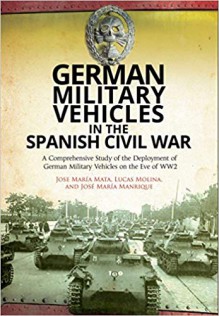
Thanks to Rosie Croft from Pen & Sword for sending me an early hardback copy of this book, which I freely chose to review.
I am not a connoisseur when it comes to military history or military vehicles, but I have recently become fascinated by unusual documents and photographs about the war, as they have the power to make the past come to life in a vivid way even for those who never experienced it. In the case of this book, 2019 marked the 80th anniversary of the end of the Spanish Civil War, and I have watched programmes and read articles about different aspects of it. Many talked about the air raids by Italian and especially German bombers in support of the Nationalist army and against the Republic, which worked well as a testing ground of their equipment prior to WWII. When I saw this book, it struck me that I hadn’t heard anything about other German vehicles used during the Spanish Civil War, although it made perfect sense that they would also send other military equipment to aid the war effort. And I felt curious.
This book is a treasure throve of pictures of the vehicles used in the Spanish Civil War. Apart from the photographs of vehicles (and not only German, as there is also the odd captured vehicle, like some Russian tanks), there are also pictures of insignias, medals, and some fabulous illustrations, both in black and white and in colour, of the vehicles and the soldiers. The collection includes tanks, cars, buses, trucks, ambulances, motorbikes (some with sidecars), and plenty of support vehicles (signal vehicles, anti-tank, anti-aircraft vehicles, mobile communication units…), and of course, the soldiers as well.
The text is minimal, and it contains factual information about the negotiations with the Germans, the number of vehicles and men they sent to train the rebel army, where they were posted, and there are also some charts summarising the numbers and the makes of the vehicles in each unit. As the authors explain, it is difficult to be precise when it comes to numbers, and in fact they ask readers to get in touch if they find any discrepancies or have any further information that can be updated in future editions.
The main interest for a non-expert like me, apart from seeing many pictures of vehicles I’d never seen before, was to see the soldiers and the different locations also. Many of the pictures are clearly posed, but some seem to have caught soldiers going about their everyday lives (peeling potatoes, chatting, washing by the river…). There are no overly dramatic pictures or action pictures as such, but the uniforms, insignias, and vehicles could prove invaluable to historians and writers interested in obtaining an accurate description of the era. I also read reviews that commented on how useful such a book would be for people interested in building realistic military models, and by the same token, it would also be useful to people who provide props or create sets for movies or TV programmes.
I missed an index and a bibliography, although the book seems to be based on an individual collection, that of J.M. Campesino, and that might explain why there is no detailed information.
This is a book that will delight fans of military history and military vehicles, with the added interest that many of those vehicles were tried and tested in Spain first and were later put to use in WWII. The authors have published a number of books in Spanish on historic subjects related mostly to the Spanish Civil War, and I understand that Pen & Sword are working on publishing other related titles. An informative and visually engaging book about a period of Spanish history that remains very present, and we should never forget.

 Log in with Facebook
Log in with Facebook 





